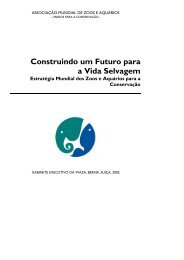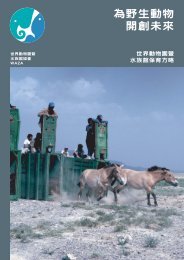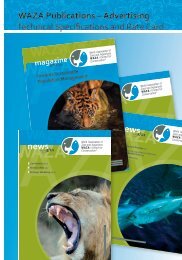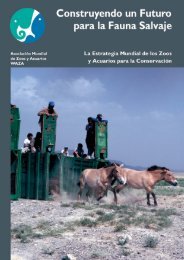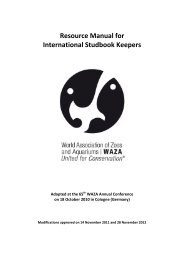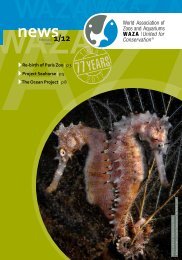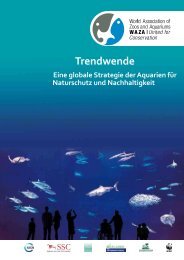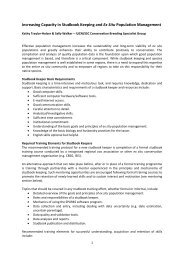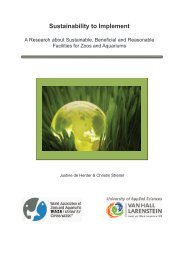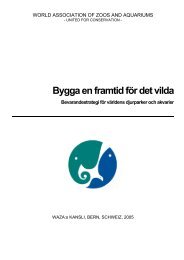Towards Sustainable Population Management - Waza
Towards Sustainable Population Management - Waza
Towards Sustainable Population Management - Waza
You also want an ePaper? Increase the reach of your titles
YUMPU automatically turns print PDFs into web optimized ePapers that Google loves.
WAZA magazine Vol 12/2011 Mate Choice 25<br />
representing male vigour and territory<br />
ownership, suggesting another<br />
approach to influencing choice. In<br />
some species, dominant males mark<br />
over scent marks of competitors and<br />
females prefer the male that marks<br />
on top. Managers could use this<br />
strategy to create a “winner” by adding<br />
scent samples sequentially so that<br />
scent from the male best for achieving<br />
population goals is added last.<br />
Females also can be influenced by<br />
the behaviour of other females and<br />
may prefer males that other females<br />
have chosen. Thus, appropriate social<br />
groups may facilitate mate acceptance,<br />
even acceptance of males that<br />
might not have been selected were<br />
the females housed individually.<br />
Given the clear importance of mate<br />
choice in so many species, we believe<br />
the zoo community should consider<br />
incorporating choice in captive<br />
breeding programmes. This should<br />
be approached, however, in a careful<br />
and controlled manner. Not only<br />
is the phenomenon of mate choice<br />
very complex, but allowing mate<br />
choice could be challenging, both<br />
the logistics of offering choice and<br />
implementing choice so that it augments<br />
rather than hinders population<br />
management goals.<br />
Recognising the complexity of this<br />
topic, a Mate Choice Symposium was<br />
held at Saint Louis Zoo in March 2010,<br />
where top scientists who study mate<br />
choice came together with zoo population<br />
managers, including studbook<br />
keepers, species coordinators and<br />
population management advisors.<br />
After a series of research presentations<br />
by the scientists summarising<br />
the mechanisms and consequences of<br />
mate choice across a wide variety of<br />
species, taxon-based working groups<br />
discussed the implications of mate<br />
choice, opportunities for incorporating<br />
mate choice in captive management<br />
and potential research projects<br />
to investigate these issues. Participants<br />
identified possible strategies<br />
for incorporating mate choice into<br />
our current breeding programmes,<br />
including: (1) using information on<br />
mate choice to increase the reproductive<br />
success of genetically valuable<br />
animals; (2) providing multiple<br />
genetically acceptable mates rather<br />
than a single mate; (3) developing<br />
methods for assessing mate acceptability<br />
(via testing of odour or other<br />
cues) before actual animal transfer;<br />
and (4) considering alternate breeding<br />
strategies such as specialised<br />
breeding centres or inter-institutional<br />
management that optimises reproductive<br />
success combined with<br />
periodic exchange of individuals.<br />
The results of this symposium along<br />
with two smaller, related workshops<br />
led to the identification of three<br />
proposed research projects that span<br />
a breadth of taxa, breeding systems<br />
and captive management to address<br />
issues related to incorporating mate<br />
choice into zoo-managed programmes.<br />
These studies are designed<br />
to evaluate the effects of allowing<br />
controlled mate choice within the<br />
following populations: a multi-zoo<br />
breeding programme for a highprofile<br />
species (cheetahs), a single-facility<br />
breeding centre (tanagers) and<br />
a controlled experimental population<br />
(mice). Funding is now being sought<br />
to support these proposed projects.<br />
It is hoped that such studies can serve<br />
as models to help guide the effective<br />
use of mate choice in zoo populations.<br />
Allowing choice may improve reproductive<br />
success and, ultimately,<br />
programme effectiveness. A better<br />
understanding of mate choice can<br />
help population managers reach their<br />
goals for viable, genetically healthy<br />
populations, while potentially helping<br />
minimise selective changes to<br />
captivity and providing insight into<br />
developing a more effective breeding<br />
management strategy for captive<br />
animal populations.<br />
Acknowledgements<br />
We thank Regina Mossotti for use of<br />
the cheetah images.<br />
References<br />
• Asa, C. S., Traylor-Holzer, K. &<br />
Lacy, R. C. (2011) Can conservation-breeding<br />
programmes<br />
be improved by incorporating<br />
mate choice? International Zoo<br />
Yearbook 45: 203–212.<br />
• Baker, A. (2007) Animal ambassadors:<br />
an analysis of the effectiveness<br />
and conservation impact of<br />
ex situ breeding efforts. In: Zoos<br />
in the 21st Century: Catalysts for<br />
Conservation? (ed. by Zimmermann,<br />
A., Hatchwell, M., Dickie,<br />
L. A. & West, C.), pp. 139–154.<br />
Cambridge: Cambridge University<br />
Press.<br />
• Conway, W. G. (2011) Buying<br />
time for wild animals with zoos.<br />
Zoo Biology 30: 1–8.<br />
• Lacy, R. C. (1994) Managing genetic<br />
diversity in captive populations<br />
of animals. In: Restoration<br />
of Endangered Species (ed. by<br />
Bowles, M. L. & Whelan, C. J.), pp.<br />
63–89. Cambridge: Cambridge<br />
University Press.<br />
• Lees, C. M. & Wilcken, J. (2009)<br />
Sustaining the Ark: the challenges<br />
faced by zoos in maintaining<br />
viable populations. International<br />
Zoo Yearbook 43: 6–18.<br />
• Mossotti, R. H. (2010) Female<br />
reaction to male urine scents<br />
as a potential indicator of mate<br />
choice in captive cheetahs<br />
(Acinonyx jubatus). MSc thesis,<br />
Southern Illinois University, Carbondale,<br />
IL.



